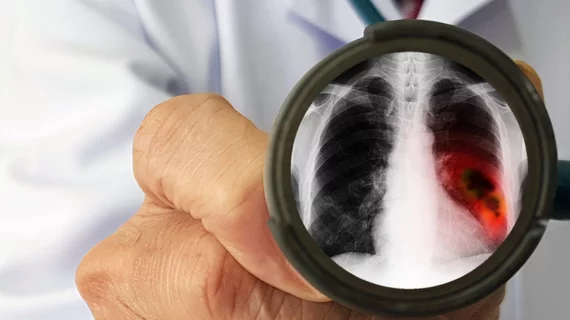Radiologists overlook lung lesion on X-ray leading to nearly 5-year cancer diagnosis delay
Two radiologists are accused of overlooking a lung lesion on a radiograph, resulting in a nearly five-year delay in one patient’s cancer diagnosis.
The controversy dates to February 2017 when a woman visited her primary care physician complaining of coughing with phlegm. She was X-rayed in June, and a radiologist noted an abnormality in the right lower lobe. However, he mistakenly identified the discovery as a “nipple shadow.”
The woman was eventually diagnosed with lung cancer in late 2021 and filed a complaint with New Zealand’s Health & Disability Commissioner, which investigates consumer concerns. Investigators issued their findings from the inquiry on Jan. 28, determining the two radiologists breached the country’s code of conduct.
“I consider that systemic issues, such as workplace pressures and an inadequate working environment, were largely responsible for the breach that occurred in the misinterpretation of Ms. A’s chest X-rays in 2017 and 2019,” wrote Dr. Vanessa Caldwell, Deputy Health and Disability Commissioner.
Ms. A had just finished her medication for a chest infection in February 2017 but was “still wheezy” and coughing. She was again seen by her family physician in May, noting she had coughed up dark blood two months prior. The doctor referred Ms. A for X-rays, highlighting her history as an ex-smoker and asthmatic who also potentially had COPD.
A radiologist in June 2017 mistakenly reported a lung lesion as only being a nipple shadow—where the nipple surrounded by air is visible as an apparent finding within the lung. The woman returned in September 2019 after coughing and wheezing for three days with slight rhinorrhea, pain and tightness in her chest. Another X-ray was performed and compared against the 2017 images, but the second radiologist again failed to spot the growing lesion.
“[A] perceptual error appears to have been made, potentially compounded by a reference to the image only from the 2017 examination, without reviewing the report which notes an abnormality (albeit incorrectly interpreted as a nipple shadow),” the report noted. “In 2019 no abnormality was detected by the reporting radiologist; however, it is acknowledged that, again in hindsight, a lesion is visible in the right lower lung and has increased in size. It no longer resembles a nipple shadow, and if the lesion had been appreciated, it is likely that a malignant diagnosis would have been made.”
Ms. A returned in November 2021 complaining of green mucus and symptoms of COPD. A radiologist finally diagnosed her cancer case on a follow-up CT in December while noting that the concern should have been spotted in 2017 and 2019. She was diagnosed with stage 3 lung cancer and was still undergoing testing and treatment in May 2024.
The organization has since made several changes in response to the incident. All radiography rooms in the region have been upgraded to industry-standard digital systems. They’re holding regular radiology quality improvement meetings to facilitate collective learning. And Health New Zealand has made “workforce a priority so that sufficient radiologists can be recruited and trained to provide sustainable service.” This has included recruitment from oversees and the implementation of a new training program. They’re also auditing reports and have implemented a “duty radiologist” to facilitate uninterrupted work for physicians to “decrease any lapse in concentration due to distractions.”
Caldwell also recommended providing a written apology to Ms. A for the breach.
“While I acknowledge that the purpose of this investigation was not to determine whether earlier detection of Ms. A’s lung cancer would have changed her long-term prognosis, I note that it is apparent from the clinical records and submissions…that later detection affected Ms. A’s treatment options in that she was not a candidate for surgery,” Caldwell wrote. “This case highlights the significance of missed opportunities in interpreting radiology scans, and I trust that Health NZ Taranaki will consider this when moving forward with providing radiology services to its patients.”

